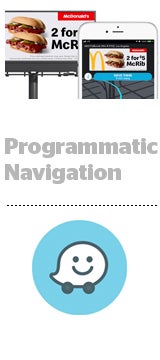Waze is navigating toward programmatic.
The traffic and navigation app owned by Google said Wednesday it has made its Zero-speed Takeover ad unit available programmatically in Display & Video 360 (formerly known as DoubleClick Bid Manager). The unit shows up as a banner ad at the bottom of the screen when a driver stops their car, and buyers can target Waze’s 115 million users with first-, second- or third-party data.
Other Waze ad units, including search ads and branded navigation pins, are still being sold direct. But activating zero-speed takeover units in DV360 is the first major integration Waze has made with Google’s marketing stack since being acquired by the company in 2013.
“Waze is now part of the Google programmatic platform,” said Felipe Almeida, head of product marketing at Waze ads. “We’re making it easier for buyers to access Waze inventory.”
Almeida declined to share how many buyers are purchasing the zero-speed unit programmatically. Waze plans to make more ad formats available programmatically in the future, but zero-speed takeovers are easiest to scale as an audience buy, he added.
Waze also said it’s integrating with Campaign Manager, Google’s buy-side ad server, so buyers can measure their Waze campaigns against other buys and control for reach and frequency. In a test and control experiment, Waze found that ads on its platform drove 36% more customers into stores, said Suzie Reider, managing director of Waze ads.
“At first, the messaging for Waze was around branding,” she said. “But in this day and age, you have to be able to help your customers grow.”
The navigation app also launched a new partnership with IRI that allows it to measure sales lift for CPG products in store. Waze ads drove a 6% lift in sales for Danone in France during a test.
“This is massive from a CPG standpoint,” he said. “We’re tying Waze ads to business performance.”
Billboards and SMBs
Waze is also making a big play for out of home (OOH) and small business budgets.
The company recently brought on Todd Palatnek as OOH business lead to work with agencies looking to augment their OOH buys with Waze ads on mobile.
For example, a campaign that geofenced McDonald’s billboards in Southern California and served complementary ads to nearby Waze users racked up 6.4 million impressions and 8,400 navigations to McDonald’s locations in eight weeks. McDonald’s reached 1.9 million unique users through the campaign.
Waze eventually wants to target ads on digital billboards, but it’s early days.
“We’re in a major education phase with the out of home agencies right now,” Palatnek said.
Waze is also going after small business budgets. The platform now works with 30,000 SMBs, double the amount it worked with last year, and launched an API for its channel partners to support SMBs as they scale Waze campaigns using their own dashboards.
“It’s all about getting people to locations,” Reider said. “How do you get people to walk into stores rather than buying online?”















